Gebali F. Analysis Of Computer And Communication Networks
Подождите немного. Документ загружается.

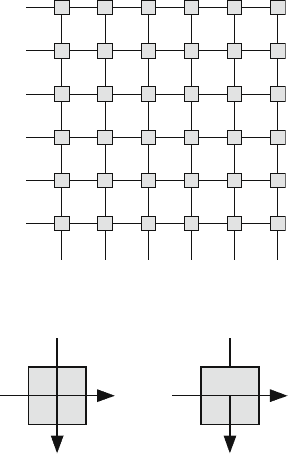
14.6 Crossbar Network 511
14.6 Crossbar Network
Crossbar switches have not been well represented in the literature, with the excep-
tion of [7], perhaps due to the original article by Clos [8], in which he claimed that
a crossbar network is very expensive to implement. With the current state of VLSI
technology, it is possible to place several switching elements and their state registers
on a single chip with the only limitation being the number of I/O pins and pad size
[2]. Happily, several companies already produce high-speed network switches built
around a crossbar network [9–11].
An N × N crossbar network consists of N inputs and N outputs. It can connect
any input to any free output without blocking. Figure 14.2 shows a 6 × 6 crossbar
network. The network consists of an array of crosspoints (CP) connected in a grid
fashion. CP(i, j) lies at the intersection of row i with column j. Each CP operates
in one of two configurations as shown in Fig. 14.3. The X-configuration is the de-
fault configuration where the SE allows simultaneous data flow in the vertical and
horizontal directions without interference. If CP(3,5) was in the X-configuration,
then data flowing horizontally originates at input 3 and is sent to all the intersection
points at this row. Data flowing vertically in column 5 could have originated from
any input above or below row 3.
In the T-configuration, the CP allows data flow in the horizontal direction and
interrupts data flow in the vertical direction. Data flowing vertically at its output is a
copy of the horizontal data. For example, if CP(3,5) was in the T-configuration, then
data flowing horizontally originates at input 3. Data flowing downward at the output
Fig. 14.2 A6×6 crossbar
interconnection network
1
2
3
5
4
6
1
23456
Outputs
Inputs
Fig. 14.3 States of the
crosspoint (CP) in a crossbar
network
X-configuration T-configuration
512 14 Interconnection Networks
is a copy of the horizontal data coming from row 3. This way, output at column 5
sees a copy of the data that was moving in row 3.
A crossbar network supports high capacity due to the N simultaneous connec-
tions it can provide. This comes at the expense of the number of CPs that grows as
N
2
. This is one reason why a crossbar network is used mainly for demanding appli-
cations that requires a relatively small values of N (about 10). However, advances
in VLSI technology and electro-optics make crossbar switches a viable switching
alternative.
Data multicast in a crossbar network can be easily accomplished. Suppose that
input 3 requests to multicast its data to outputs 1, 3, and 5. Input 3 would then
request to configure CP(3,1), (3,3), and (3, 5) into the T -configuration and all other
CPs in row 3 would remain in the default X-configuration.
14.6.1 Crossbar Network Contention and Arbitration
Suppose that two or more inputs request access to the same output. In that case,
contention arises and some arbitration mechanism has to be provided to settle this
dispute. In fact, we have to provide N arbiters such that each one is associated with
a column in the crossbar network. For example, when input 1 requests to commu-
nicate with output 3, it requests to configure CP(1,3) into the T -configuration and
must wait until the arbiter in column 3 issues a grant to that input. At the same time,
the arbiter in column 3 must inform all other inputs that they cannot access column
3 in that time step. This happens only after the arbiter checks to see if there are
any requests coming from other inputs demanding access to output 3. These arbiters
slow down the system especially for large networks where signal propagation up
and down the columns takes a substantial amount of time.
Arbitration was necessary because access to the crossbar network was input
driven where the inputs issue the requests to configure the crosspoint switches. In
an output-driven crossbar network, the outputs initiate issuing of requests for data
from the inputs and this eliminates the need for the arbiters. Needless to say, this
mode of operation leads to much faster switch operation and was first proposed by
the author in references [12–14].
14.6.2 Analysis of Crossbar Network
The crossbar switch can be considered as a collection of N shared media, viz., the
columns of the crossbar network, since each column is associated with an output
link or channel. All N columns operate in parallel and each output accepts traffic
from all N inputs (rows). Thus the traffic arriving at each output port is a fraction of
the traffic arriving at the inputs.
Assume a is the packet arrival probability at an input port of an N × N crossbar
switch. Let us study the activity of a certain output port. We call this the tagged

14.6 Crossbar Network 513
output port. The probability that a packet arrives at any input port such that it is
destined to the tagged output port is given by
a
=
a
N
(14.1)
This is because an arriving packet has an equal probability of requesting one of
N output ports. Essentially, each output port deals with N users but the probability
of packet arrival is reduced to a/N. The probability that i requests arrive at a time
slot addressed to the tagged output port is given by
p(i) =
N
i
a
N
i
1 −
a
N
N−i
(14.2)
The input traffic N
a
(in) that is destined for the tagged output port per time slot is
given by
N
a
(in) = E
[
ip
(
i
)
]
=
N
i=0
ip
(
i
)
= a (14.3)
The throughput of the tagged output port is equal to the output traffic of the
tagged output port and is given by the expression
Th =
N
i=1
p(i) = 1 − p(0) (14.4)
After substituting the value for a
we could write
Th = N
a
(out)
= 1 −
1 −
a
N
N
packets/time step (14.5)
The second term in the RHS is simply the probability that no packets are destined
to the tagged output port. For light loading, we get Th ≈ a which indicates that most
of the arriving packets are transmitted.
In the limit for large networks (N →∞), we get
Th = lim
N→∞
1 −
1 −
a
N
N
= 1 −e
−a
packets/time step (14.6)
For very large crossbar network at very light loads a 1, we get Th → a which
indicates that almost all the arriving packets make it through the switch due to the
light loading.

514 14 Interconnection Networks
What is really exciting is the performance of very large crossbar networks under
extremely heavy loading. The maximum throughput Th(max) occurs at very heavy
traffic (a = 1):
Th(max) = 1 −e
−1
= 63.21% packets/time step (14.7)
Thus the crossbar network is characterized by very high throughput even at the
highest load and for large networks.
From (14.3) and (14.5), the packet acceptance probability is given by
p
a
=
N
a(out)
N
a(in)
=
1
a
1 −
1 −
a
N
N
(14.8)
For light traffic (a 1), we get p
a
≈ 1 which indicates very high efficiency. In
the limit for large networks, we get
p
a
= lim
N→∞
1
a
1 −
1 −
a
N
N
=
1 −e
−a
a
(14.9)
The minimum acceptance probability p
a
(min) occurs at very heavy traffic
(a = 1):
p
a
(min) = 1 −e
−1
= 63.21% (14.10)
Thus the crossbar network is characterized by very high acceptance probability
even at the highest load and for large networks.
The delay of the network is defined as the average number of attempts to access
the desired output. The probability that the packet succeeds after k tries is given by
the geometric distribution
p(k) = p
a
(
1 − p
a
)
k
(14.11)
The average delay time is
n
a
=
∞
k=0
kp(k)
=
∞
k=0
kp
a
(
1 − p
a
)
k
=
1 − p
a
p
a
time steps (14.12)
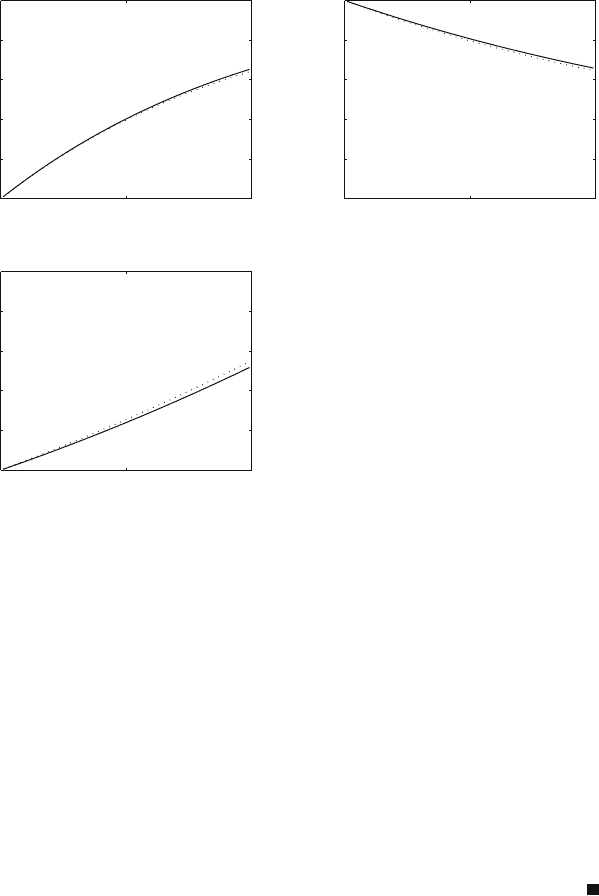
14.7 Multistage Interconnection Networks 515
0
0.2
0.4
0.6
0.8
1
Throughput
0 0.5 1
0
0.2
0.4
0.6
0.8
1
Input traffic
Acceptance probability
0 0.5 1
0
0.2
0.4
0.6
0.8
1
Input traffic
0 0.5 1
Input traffic
Delay
Fig. 14.4 Variation of the throughput, the packet acceptance probability, and the delay with the
input traffic for the crossbar network when N = 8(solid line)andN = 16 (dotted line)
For light traffic (a ≈ 0), we get n
a
≈ 0 which indicates that arriving packets get
through on their first attempt. For heavy traffic, a = 1 and the maximum number of
attempts becomes 0.582 on the average.
Example 14.1 Plot the throughput (Th), the access probability (p
a
), and the average
delay (n
a
) versus the input traffic for the crossbar network when the size of the
network is N = 8 and N = 16.
We evaluate the expressions for throughput, packet acceptance probability, and
delay when N has the values 8 and 16 and a is varied. Figure 14.4 shows the vari-
ation of throughput, the packet acceptance probability, and the delay with the input
traffic when N = 8 (solid line) and N = 16 (dotted line). We see that the minimum
throughput is around 63.66% and occurs at a = 1. What is striking is the good
overall performance of the crossbar network and the little dependence on N.
14.7 Multistage Interconnection Networks
As Fig. 14.5 shows, an N × N multistage interconnection network consists of n
stages with stage i connected to stages i − 1 and i + 1 through some pattern of
connection lines. Each stage has w crossbar switching elements (SE) that vary in
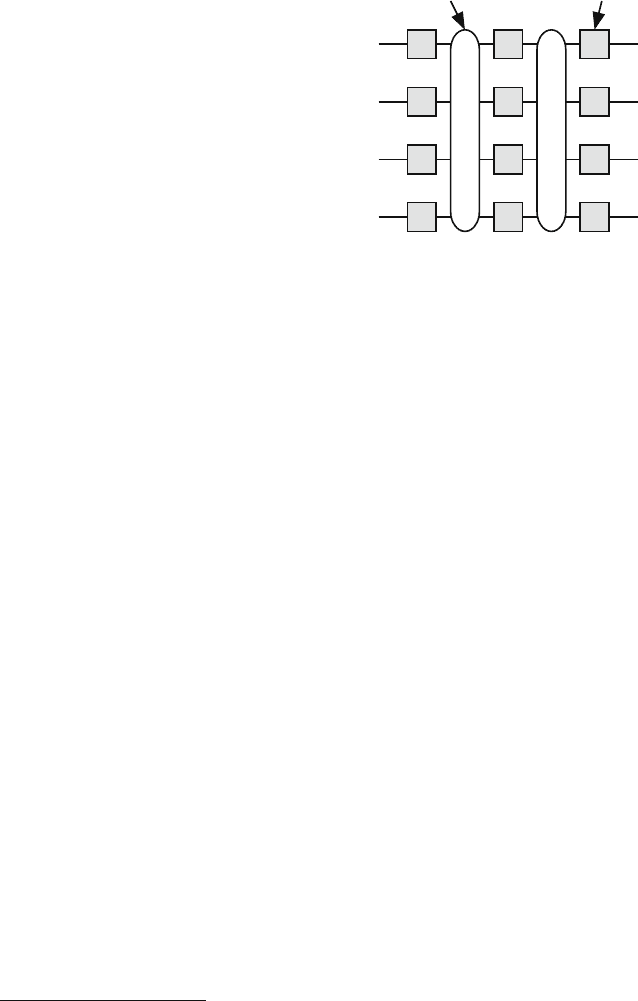
516 14 Interconnection Networks
Fig. 14.5 A4×4 MIN with
three stages and four switches
per stage
Stage: 0
Connection
Links
0
1
2
4
12
Switching
Element (SE)
0
1
2
4
0
1
2
4
Inputs
Outputs
size from 2 × 2 and up. The SEs in each stage are numbered starting at the top as
shown. For the MIN in the figure, we have N = 4, n = 3, and w = 4. The labeling
of the stages and switches is also shown in the figure. Typically, the number of
stages
1
n = lg N. The design parameters for a MIN are the size of the network
N, the number of stages n, the number of switches per stage w, and the size of
each switch. These four factors determine the MIN complexity. Another important
measure of the cost of a MIN is the number and length of the wires in the connection
links between the stages. This last factor determines the required number of pins or
connections at every level of integration or packaging. MINs are classified into three
classes according to the ability of the network to establish a path between an input
and an output [4, 15]:
Blocking MIN: A connection between a free input/output pair cannot be estab-
lished due to conflicts with already-existing connections. This blocking is
called internal blocking since the internal wiring of the network prevented
path establishment. This type of MIN usually has a single path connecting
any input/output pair which leads to hardware economy at the cost of reduc-
ing the fault tolerance and the throughput due to internal blocking.
Nonblocking MIN: A connection between a free input/output pair can be es-
tablished independent of already-existing connections. This type of MIN has
many alternative routes connecting any input/output pair which makes them
expensive to implement although they are not as expensive as a crossbar
network.
Rearrangeable MIN: Any input can be connected to any free output port by
rearranging existing connections. Rearrangeable networks should not be con-
fused with nonblocking networks that do not rearrange existing paths to
establish new connections. Rearrangeable networks are less expensive than
nonblocking or crossbar networks.
1
We use Knuth’s [11] notation “lg N” to denote the base-2 logarithm log
2
N.

14.7 Multistage Interconnection Networks 517
14.7.1 Definitions
We start our study of MINs by defining some functions that are commonly used in
the field of multistage interconnection networks:
Shuffle function: Assume the label for a row in the MIN is represented as binary
number A. The perfect shuffle function S performs a circular left shift on the
bits of A:
A = a
n−1
a
n−2
··· a
1
a
0
S(A) = a
n−2
a
n−3
··· a
0
a
n−1
Inverse shuffle function: The inverse perfect shuffle function S
−1
performs a
circular right shift on the bits of A:
A = a
n−1
a
n−2
··· a
1
a
0
S
−1
(A) = a
0
a
n−1
··· a
2
a
1
Exchange function: The exchange function E
i, j
exchanges the bits at positions
i and j leaving all other bits intact:
A = a
n−1
··· a
i
··· a
j
··· a
0
E
i, j
(A) = a
n−1
··· a
j
··· a
i
··· a
0
Butterfly function: The butterfly function B
i
exchanges the least significant bit
(a
0
) and the ith bit (a
i
) of the binary number leaving all other bits intact:
A = a
n−1
··· a
i+1
a
i
a
i−1
··· a
0
B
i
(
A
)
= a
n−1
··· a
i+1
a
0
a
i−1
··· a
i
Cube function: The cube function C
i
complements the ith bit (a
i
) of the binary
number leaving all other bits intact:
A = a
n−1
··· a
i+1
a
i
a
i−1
··· a
0
C
i
(
A
)
= a
n−1
··· a
i+1
a
i
a
i−1
··· a
0
Plus–Minus 2
i
(PM2I) function: The plus–minus 2
i
(PM2I) function adds ±2
i
to the row address of a packet. The result is reduced using the modulo func-
tion as follows:
PM2
+i
(
A
)
=
A +2
i
mod N
PM2
−i
(
A
)
=
A −2
i
mod N
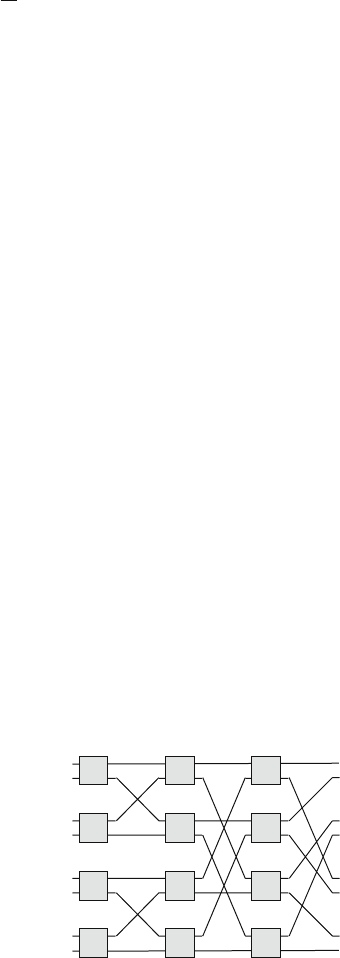
518 14 Interconnection Networks
where i varies between 0 and n = lg N. Notice that the C
i
function could be
implemented using the PM2I function:
C
i
(
A
)
= A +
a
i
PM2
+i
(
A
)
−a
i
PM2
−i
(
A
)
Below we show examples of several MINs that were proposed for applications
in communications.
14.8 Generalized-Cube Network (GCN)
Figure 14.6 shows an 8 ×8 generalized-cube network [16, 17]. The interconnection
pattern of the network is based on the cube and shuffle functions. For an N × N
network, the number of stages is n where n = lg N and the number of SEs in
each stage is N/2. Each SE is a 2 × 2 crossbar switch and the number of links
between stages is N. This network is equivalent to many other networks that were
proposed such as the omega [18], banyan [19], delta, and baseline. The generalized-
cube network is a blocking network and provides only one path from any input to
any output. As such, it possesses no tolerance for faults.
Switching element SE(i, j) at stage i and position j is connected to SE(i +1, k)
such that k is given by
k =
j straight connection
C
i
(
j
)
cube connection
(14.13)
where 0 ≤ i < n and 0 ≤ j < N/2. Note that the SE row label j requires only n−1
bits for its representation. Thus when N = 8, the switch row label is composed only
of two bits.
As an example, SE(1,2) at stage 1 is connected to switches SE(2,2), the straight
connection, and switch SE(2,0), the C
1
(
2
)
connection.
Fig. 14.6 Generalized-cube
network for N = 8
0
0
1
2
4
12
3
5
6
7
Inputs
Outputs
Stage
1
2
3
1
2
3
1
2
3
000
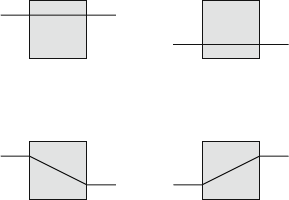
14.8 Generalized-Cube Network (GCN) 519
At the last stage, output stage, switch SE(2, j) is connected to row k such that k
is given by
k =
j straight connection
C
2
(
j
)
cube connection
(14.14)
where 0 ≤ j < N. Note that the output row label j requires only n − 1 for its
representation. Thus when N = 8, the switch row label is composed of three bits.
As an example, SE(2,3) is connected to output rows 3 and 7 since we have j = 3
which has the binary equivalent 011 and applying the straight and cube connection
C
2
(3) gives output rows 3 and 7, respectively.
The GCN provides one unique path from any input to any output based on the
input row address and the destination address. The packet path is established by
properly configuring the connections within each SE that the packet goes through.
Figure 14.7 shows the two types of connections that could be simultaneously estab-
lished for the two inputs of an SE at stage i:
Straight connection: The packet enters and exits at the same row location.
Cube connection: The packet enters at row location R and exits at row location
C
i
(
R
)
.
Depending on the SE design, one SE input could simultaneously establish the
straight and cube connections for itself, while the other input will not be able to
access the two outputs. This situation is useful to broadcast packets to two or more
outputs.
14.8.1 Routing Algorithm for GCN Network
The routing algorithm in GCN is distributed among the SEs and is based on per-
forming a bitwise XOR operation on the source row address (S) and destination row
address D. S indicates the row location of the input port and D indicates the row
Fig. 14.7 The straight and
cube connections for each
input of an SE in a GCN
network
The straight connection for
each input
The cube connection for each
input
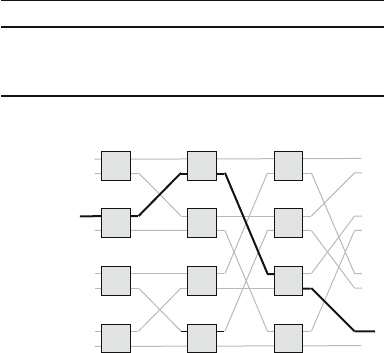
520 14 Interconnection Networks
location of the desired output port. The routing vector r is used to determine the
path of the packet through the network. r is obtained as follows:
r = XOR
(
S, D
)
(14.15)
where the n-bit routing vector r carries the information about the desired path. Bit i
of that vector specifies the type of connection of the SE at stage i:
r
i
=
⎧
⎨
⎩
0 straight connection
1 cube connection
(14.16)
For an 8 ×8 GCN network n = lg 8 = 3 and the routing vector r will have three
bits. If an incoming packet arrives at row 2 (binary 010) and is destined to row 6
(binary 110), then we have
S =
010
t
(14.17)
D =
110
t
(14.18)
r =
100
t
(14.19)
The path selected is explained in Table 14.1.
Figure 14.8 shows the path chosen to route a packet from input at row 2 to output
at row 6 based on binary bit pattern of routing vector r.
Table 14.1 SE settings for
path in GCN network from
input 2 to output 6
Stage i = 0 i = 1 i = 2
Bit scanned r
0
r
1
r
2
Bitvalue 001
Connection type Straight Straight Cube
Fig. 14.8 Path chosen in the
GCN network to route a
packet from input at row 2 to
output at row 6 based on
binary bit pattern of routing
vector r
0
1
2
4
3
5
6
7
012
Inputs
Outputs
Stage
1
2
3
1
2
3
1
2
3
000
